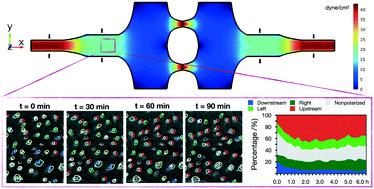Our official English website, www.x-mol.net, welcomes your
feedback! (Note: you will need to create a separate account there.)
Endothelial cell polarization and orientation to flow in a novel microfluidic multimodal shear stress generator
Lab on a Chip ( IF 6.1 ) Pub Date : 2020-10-20 , DOI: 10.1039/d0lc00738b Utku M Sonmez 1 , Ya-Wen Cheng , Simon C Watkins , Beth L Roman , Lance A Davidson
Lab on a Chip ( IF 6.1 ) Pub Date : 2020-10-20 , DOI: 10.1039/d0lc00738b Utku M Sonmez 1 , Ya-Wen Cheng , Simon C Watkins , Beth L Roman , Lance A Davidson
Affiliation

|
Endothelial cells (EC) respond to shear stress to maintain vascular homeostasis, and a disrupted response is associated with cardiovascular diseases. To understand how different shear stress modalities affect EC morphology and behavior, we developed a microfluidic device that concurrently generates three different levels of uniform wall shear stress (WSS) and six different WSS gradients (WSSG). In this device, human umbilical vein endothelial cells (HUVECs) exhibited a rapid and robust response to WSS, with the relative positioning of the Golgi and nucleus transitioning from a non-polarized to polarized state in a WSS magnitude- and gradient-dependent manner. By contrast, polarized HUVECs oriented their Golgi and nucleus polarity to the flow vector in a WSS magnitude-dependent manner, with positive WSSG inhibiting and negative WSSG promoting upstream orientation. Having validated this device, this chip can now be used to dissect the mechanisms underlying EC responses to different WSS modalities, including shear stress gradients, and to investigate the influence of flow on a diverse range of cells during development, homeostasis and disease.
中文翻译:

新型微流体多模式剪切应力发生器中内皮细胞的极化和流动方向
内皮细胞 (EC) 对剪切应力做出反应以维持血管稳态,而反应中断与心血管疾病相关。为了了解不同的剪切应力模式如何影响 EC 的形态和行为,我们开发了一种微流体装置,该装置可同时产生三种不同水平的均匀壁剪切应力 (WSS) 和六种不同的 WSS 梯度 (WSSG)。在该装置中,人脐静脉内皮细胞 (HUVEC) 对 WSS 表现出快速而强大的响应,高尔基体和细胞核的相对位置以 WSS 幅度和梯度依赖的方式从非极化状态转变为极化状态。相比之下,极化的 HUVEC 以 WSS 幅度依赖的方式将其高尔基体和核极性定向到流矢量,正 WSSG 抑制,负 WSSG 促进上游定向。经过验证该设备后,该芯片现在可用于剖析 EC 对不同 WSS 模式(包括剪切应力梯度)响应的机制,并研究流动对发育、稳态和疾病期间各种细胞的影响。
更新日期:2020-11-03
中文翻译:

新型微流体多模式剪切应力发生器中内皮细胞的极化和流动方向
内皮细胞 (EC) 对剪切应力做出反应以维持血管稳态,而反应中断与心血管疾病相关。为了了解不同的剪切应力模式如何影响 EC 的形态和行为,我们开发了一种微流体装置,该装置可同时产生三种不同水平的均匀壁剪切应力 (WSS) 和六种不同的 WSS 梯度 (WSSG)。在该装置中,人脐静脉内皮细胞 (HUVEC) 对 WSS 表现出快速而强大的响应,高尔基体和细胞核的相对位置以 WSS 幅度和梯度依赖的方式从非极化状态转变为极化状态。相比之下,极化的 HUVEC 以 WSS 幅度依赖的方式将其高尔基体和核极性定向到流矢量,正 WSSG 抑制,负 WSSG 促进上游定向。经过验证该设备后,该芯片现在可用于剖析 EC 对不同 WSS 模式(包括剪切应力梯度)响应的机制,并研究流动对发育、稳态和疾病期间各种细胞的影响。











































 京公网安备 11010802027423号
京公网安备 11010802027423号